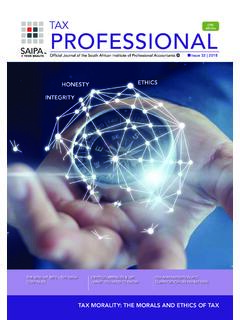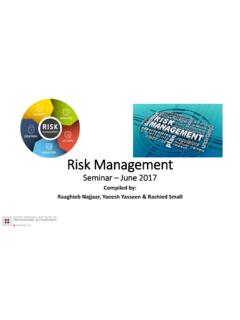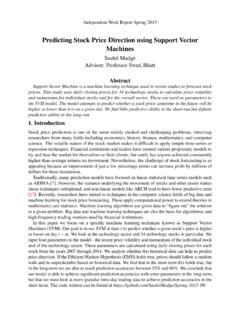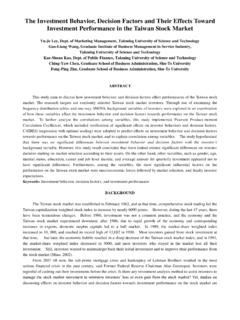Transcription of Types of Risk - Systematic and Unsystematic Risk in ...
1 Types of Risk - Systematic and Unsystematic Risk in Finance Post: Gaurav Akrani. Date: 1/25/2012. Comments (3). Label: Finance. Types of risk First let's revise the simple meaning of two words, viz., Types and risk. In general and in context of this finance article, 1. Types mean different classes or various forms / kinds of something or someone. 2. Risk implies the extent to which any chosen action or an inaction that may lead to a loss or some unwanted outcome. The notion implies that a choice may have an influence on the outcome that exists or has existed.
2 However, in financial management, risk relates to any material loss attached to the project that may affect the productivity, tenure, legal issues, etc. of the project. In finance, different Types of risk can be classified under two main groups, viz., The meaning of Systematic and Unsystematic risk in finance: 1. Systematic risk is uncontrollable by an organization and macro in nature. 2. Unsystematic risk is controllable by an organization and micro in nature. A. Systematic Risk Systematic risk is due to the influence of external factors on an organization.
3 Such factors are normally uncontrollable from an organization's point of view. It is a macro in nature as it affects a large number of organizations operating under a similar stream or same domain. It cannot be planned by the organization. The Types of Systematic risk are depicted and listed below. 1. Interest rate risk Interest-rate risk arises due to variability in the interest rates from time to time. It particularly affects debt securities as they carry the fixed rate of interest. The Types of interest-rate risk are depicted and listed below.
4 The meaning of price and reinvestment rate risk is as follows: 1. Price risk arises due to the possibility that the price of the shares, commodity, investment, etc. may decline or fall in the future. 2. Reinvestment rate risk results from fact that the interest or dividend earned from an investment can't be reinvested with the same rate of return as it was acquiring earlier. 2. market risk market risk is associated with consistent fluctuations seen in the trading price of any particular shares or securities. That is, it arises due to rise or fall in the trading price of listed shares or securities in the stock market .
5 The Types of market risk are depicted and listed below. The meaning of different Types of market risk is as follows: 1. Absolute risk is without any content. For , if a coin is tossed, there is fifty percentage chance of getting a head and vice-versa. 2. Relative risk is the assessment or evaluation of risk at different levels of business functions. For a relative-risk from a foreign exchange fluctuation may be higher if the maximum sales accounted by an organization are of export sales. 3. Directional risks are those risks where the loss arises from an exposure to the particular assets of a market .
6 For an investor holding some shares experience a loss when the market price of those shares falls down. 4. Non-Directional risk arises where the method of trading is not consistently followed by the trader. For the dealer will buy and sell the share simultaneously to mitigate the risk 5. Basis risk is due to the possibility of loss arising from imperfectly matched risks. For the risks which are in offsetting positions in two related but non-identical markets. 6. volatility risk is of a change in the price of securities as a result of changes in the volatility of a risk-factor.
7 For it applies to the portfolios of derivative instruments, where the volatility of its underlying is a major influence of prices. 3. Purchasing power or inflationary risk Purchasing power risk is also known as inflation risk. It is so, since it emanates (originates) from the fact that it affects a purchasing power adversely. It is not desirable to invest in securities during an inflationary period. The Types of power or inflationary risk are depicted and listed below. The meaning of demand and cost inflation risk is as follows: 1.
8 Demand inflation risk arises due to increase in price, which result from an excess of demand over supply. It occurs when supply fails to cope with the demand and hence cannot expand anymore. In other words, demand inflation occurs when production factors are under maximum utilization. 2. Cost inflation risk arises due to sustained increase in the prices of goods and services. It is actually caused by higher production cost. A high cost of production inflates the final price of finished goods consumed by people. B. Unsystematic Risk Unsystematic risk is due to the influence of internal factors prevailing within an organization.
9 Such factors are normally controllable from an organization's point of view. It is a micro in nature as it affects only a particular organization. It can be planned, so that necessary actions can be taken by the organization to mitigate (reduce the effect of) the risk. The Types of Unsystematic risk are depicted and listed below. 1. Business or liquidity risk Business risk is also known as liquidity risk. It is so, since it emanates (originates) from the sale and purchase of securities affected by business cycles, technological changes, etc.
10 The Types of business or liquidity risk are depicted and listed below. The meaning of asset and funding liquidity risk is as follows: 1. Asset liquidity risk is due to losses arising from an inability to sell or pledge assets at, or near, their carrying value when needed. For assets sold at a lesser value than their book value. 2. Funding liquidity risk exists for not having an access to the sufficient-funds to make a payment on time. For when commitments made to customers are not fulfilled as discussed in the SLA (service level agreements).














